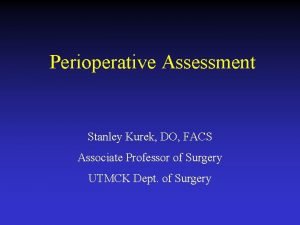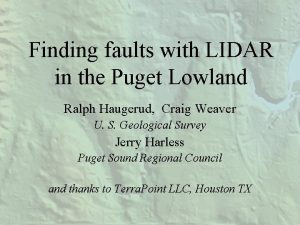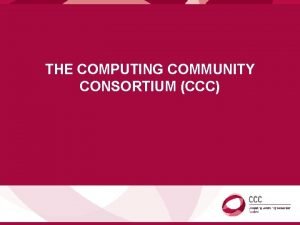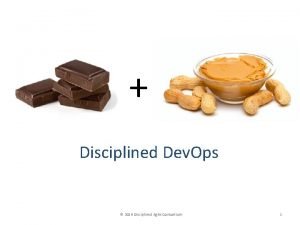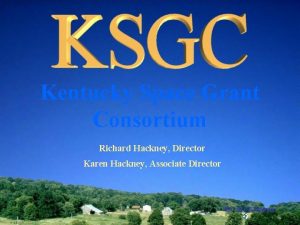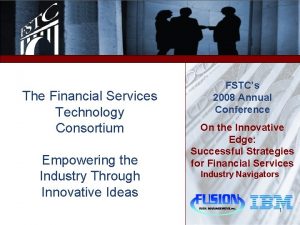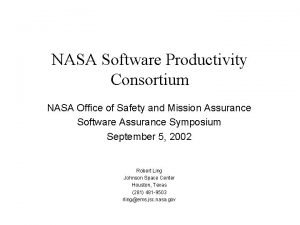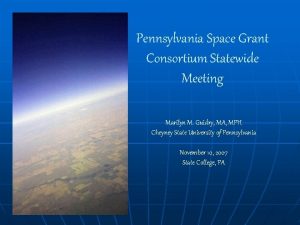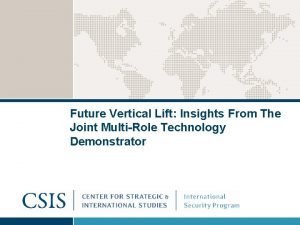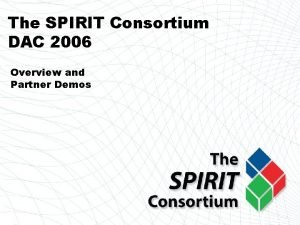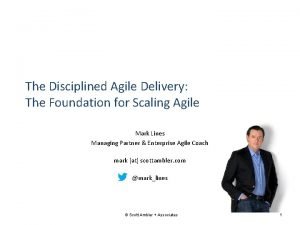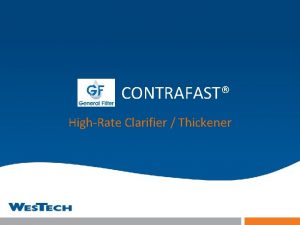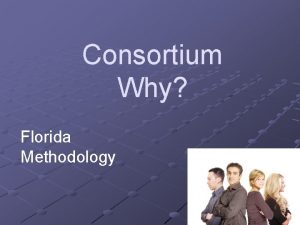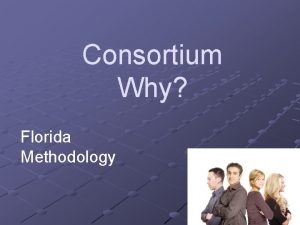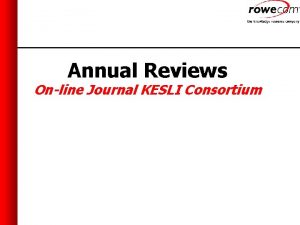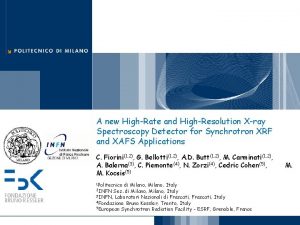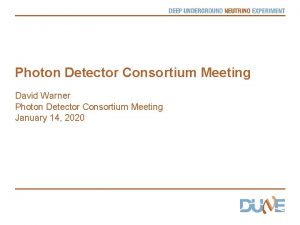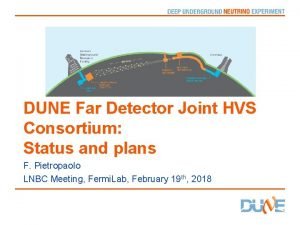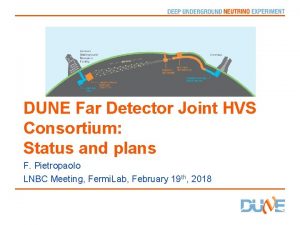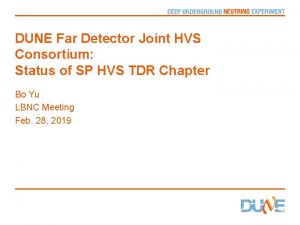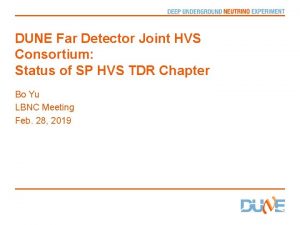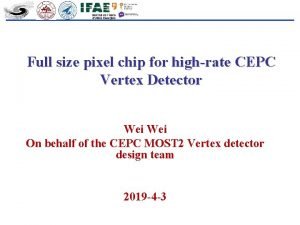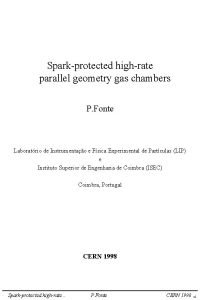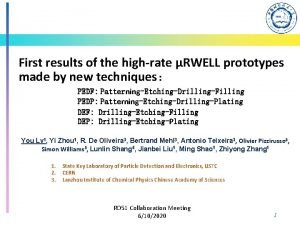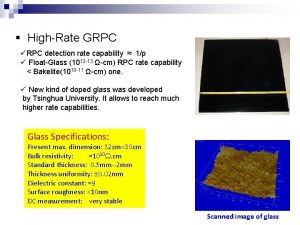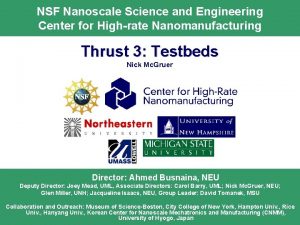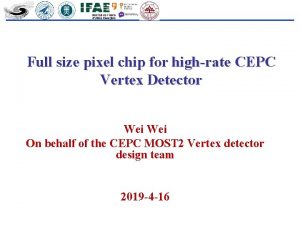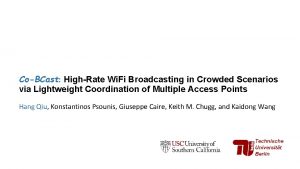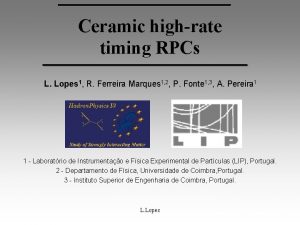Activity of highrate detector consortium status of detector






















- Slides: 22

Activity of high-rate detector consortium & status of detector developments Masaki Sasano RNC On behalf of the consortium

What should be discussed… Idea Technology Consortiu m Local RIBF researcher users s at RIBF Detector team Death valley: • Matching needs • Marketing research • Building management (operational) framework …. Big. RIPS team Scientific knowledge Scientific societal benefit Implementation & operation Need to minimize Human resource, budget, time for setup operation maintenance

Goal (Matching needs) To achieve: a total intensity ~ 3 - 5 x 100 k Hz (after F 7) (at present, Big. RIPS can accept 30 – 50 k. Hz, Z>=50) • Clear PID for nuclei for Z=50 or heavier • Standard setup

How to define “high rate”? Rate available for users on reaction target • ~ 3 - 5 x 100 k Hz (after F 7) or higher In the upstream, the beam rate can be higher: • F 3 > F 5 > F 7 (“>” can be a factor of 10— 100 or higher, depending on RI) • In focusing points, F 3 and F 7, the beam spot size is small, so the rate capability must be considered taking into account how the detector is segmented. Undetected light particles also matter: • Tritons (when one studies neutron rich side around or over A/Z=3) • F 3 > F 5 > F 7 How many days can work continuously? “ • For example, in the recently done 132 Sn experiment at ZDS with 4050 kpps in total after F 7; • F 3 PPAC 1 day • F 8/9/11 2 days replacement

Member list (2014/1/19) • Daiki Nishimura, Tokyo University of Science IC • Nigel (LP CAEN) → TDC/QDC (within some limit, dead time free) • Hidetada Baba, RNC, →DAQ, Flash ADC, FPGA • Emmanuel Pollacco • Meiko Kurokawa, RNC →ASIC, Si detectors, … → Detectors, Electronics, ASIC chips, GET… • Toshio Kobayashi, Tohoku Univ. • Alexandre Obertelli, CEA Saclay →MWDC, 1 -mm MWPC, CRDC, • Tuomas Grahn, University of Jyväskylä • Hideaki Otsu, RNC →MWDC, MWPC, IC, • Megumi Niikura, University of Tokyo • Yohei Matsuda, Kohnan Univ. →detectors • Masaki Sasano, RNC chair, IC • Shinsuke Ota, CNS, Univ. of Tokyo MWDCs, … • Yohsuke Kondo, TITECH • Juzo Zenihiro, RNC →indirect method for charge • Nori Aoi, RCNP Osaka University determination • Nobuaki Imai, CNS, Univ. of Tokyo • Kimiko Sekiguchi, Tohoku Univ. • Naoki Fukuda, RNC • P. Rykaczewski (ORNL) →Flash ADC based DAQ • Kwongbok Lee, Kwon Young Kwan, Moon • Stephanos Paschalis (Darmstadt) Jun. Young, Institute for Basic Science, Korea • Zoltan Elekes (ATOMKI)

Materials to be developed Detectors TOF: Plastic scintillator Diamond detector Charge (Z): Position: Plastic scintillator MWDC Ion chamber MWPC Silicon detector CRDC Indirect method… PPAC Fiber scinti. Si strips Auxiliary systems Micro Pattern Electronics: Vacuum: DAQ: ASIC chips Feedthrough Trigger rate Cooling of ASIC chips Time stamping Cabling Light tightness Flash ADC

Other important things to be discussed Manpower: Development Maintenance Operation Taking over skills… Radiation: Safety STQ heat load Hang up of control systems Initial investment: Running cost: Cost for development Detector material replacement Standardization • Plastic, gas, … Test beam time…

Status of detector development by the consortium members

TOF detectors Advantage Plastic scintillator Diamond detector Cheap, Easy setup Uniformity? ? ? Can be thin Radiation hardicity Disadvantage Deterioration (especially for higher Z) PMT read out (instability) Expensive, Fabrication (plating, bonding…) Small size (at present, 30 x 30 mm) Non-uniformity? ? ? Too thick for high Z?

TOF detectors Advantage Plastic scintillator Diamond detector Cheap, Easy setup Uniformity? ? ? Can be thin Radiation hardicity Disadvantage Deterioration (especially for higher Z) PMT read out (instability) Expensive, Fabrication (plating, bonding…) Small size (at present, 30 x 30 mm) Non-uniformity? ? ? Too thick for high Z? Yuki Sato-san, Michimasa-san

Michimasa-san’s work

Position detectors 1 -mm pitch MWDC MWPC Advant > 105 Hz age per wire Easy data handling Disadv antage (or issues) 105 Hz per wire achievable position resolution Can be large size CRDC PPAC Low-z Easy cabling detection Easy data Easy cabling handling Strong for rad. damage TPC Only gas material in beam line Small size Skill, man Charge Inefficiency for Long drift (32 x 32 mm 2 power readout low-z detection time (needs ) Complicated (weak for Rad. damage to cover a Skill, cabling … noises) long range manpower of TDC) Complicate d cabling … 1 -mm pitch MWPC@F 3 & CRDC @ other focal planes w/ electronics in vacuum (lower power ASD + FPGA), water cooling?

Position detectors 1 -mm pitch MWDC MWPC Advant > 105 Hz age per wire Easy data handling Disadv antage (or issues) 105 Hz per wire achievable position resolution Can be large size CRDC PPAC Low-z Easy cabling detection Easy data Easy cabling handling Strong for rad. damage TPC Only gas material in beam line Small size Skill, man Charge Inefficiency for Long drift (32 x 32 mm 2 power readout low-z detection time (needs ) Complicated (weak for Rad. damage to cover a Skill, cabling … noises) long range manpower of TDC) Complicate d cabling … 1 -mm pitch MWPC@F 3 & CRDC @ other focal planes w/ electronics in vacuum (lower power ASD + FPGA), water cooling?

Kobayashi-san’s work

Position detectors 1 -mm pitch MWDC MWPC CRDC PPAC TPC Advant > 105 Hz age per wire Easy data handling 105 Hz per wire achievable position resolution Can be large size Low-z Easy cabling detection Easy data Easy cabling handling Strong for rad. damage Only gas material in beam line Disadv antage (or issues) Skill, man power Complicated cabling … Charge readout (weak for noises) Long drift time (needs to cover a long range of TDC) Small size (32 x 32 mm 2 ) Skill, manpower Complicate d cabling … Inefficiency for low-z detection Rad. damage

Tuomas-san work

Pollacco-san and Sako-san work

Z detectors Plastic scintillator Ion chamber Silicon strip detectors Indirect method Advant Relatively easy Radiation age setup hardicity Uniformity Relatively easy operation Good Z resolution No radiation and high rate if damage highly segmented No limitation? ? ? Disadv antage (or issues) Expensive Proof of Fabrication principle… Radiation damage Combining several detectors Low resolution with small energy loss Radiation damage Some noise comes from the upstream of F 7? ? ? Pileup

Daiki Nishimura-san’s work

Materials to be developed Auxiliary systems DAQ: Electronics: Trigger rate ASIC chips Time stamping Cabling Flash ADC Vacuum: Feedthrough Cooling of ASIC chips Light tightness

Kurokawa-san and Ota-san’s work on feedthrough

Summary • In near future, a “high intensity” (total intensity of ~ 3 - 5 x 100 k Hz after F 7) must be achieved. • Developments are ongoing among the consortium and they can be merged into a standard setup at RIBF. • Need to minimize human resource, budget, time need for setup, operation, and time must be considered. • Some people are already working on very “high intensity” (~> MHz). • Auxiliary system is very important. Feedthrough is a good example.
 Dipyramadole
Dipyramadole Activity 2:
Activity 2: Activity 1 introductory activity
Activity 1 introductory activity Reactants, products and leftovers
Reactants, products and leftovers Activity 1 activity 2
Activity 1 activity 2 Debye huckel equation
Debye huckel equation Activity 2:
Activity 2: Project management aon
Project management aon Puget sound lidar consortium
Puget sound lidar consortium Ccc computing
Ccc computing Training officers consortium
Training officers consortium Disciplined agile consortium
Disciplined agile consortium Richard hackney
Richard hackney Financial services technology consortium
Financial services technology consortium Software productivity consortium
Software productivity consortium Pennsylvania space grant consortium
Pennsylvania space grant consortium Vertical lift consortium
Vertical lift consortium National consortium of interpreter education centers
National consortium of interpreter education centers Infrastructure consortium for africa
Infrastructure consortium for africa Physician consortium for performance improvement
Physician consortium for performance improvement Spirit consortium
Spirit consortium Disciplined agile delivery lifecycle
Disciplined agile delivery lifecycle Concord consortium molecular workbench photosynthesis
Concord consortium molecular workbench photosynthesis
